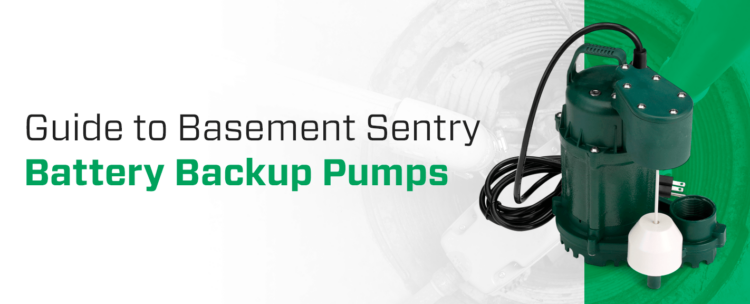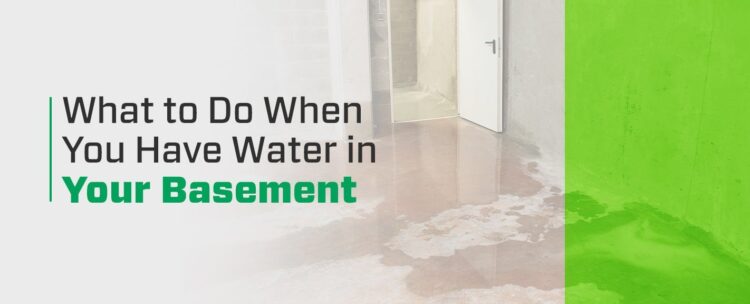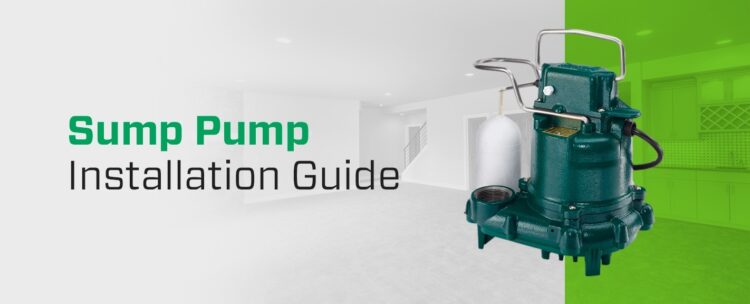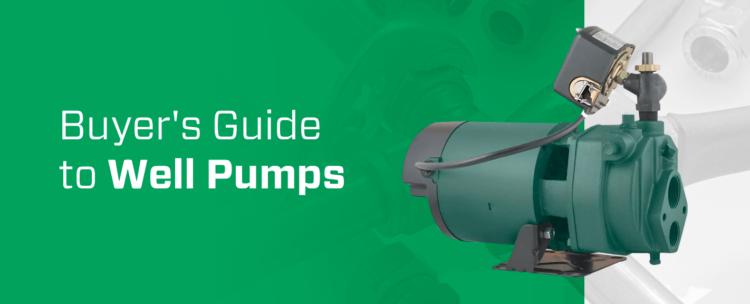Flooding can happen when you least expect it. One minute, you’re enjoying the sound of rain on your roof, and the next thing you know, you’re dealing with the mess and hassle of water damage in your home. Even a main water line burst can flood your basement. No matter the situation, you’ll be thankful to have a sump pump installed.
These handy devices are a must-have for any homeowner with part of their home below ground level. They help reduce the risk of water damage to part of your property like a basement or crawlspace. If you already live in a high-risk area, such as ones with heavy rainfall or spring snowmelt, you’ll most likely already have one installed in your home.
But what if you need to get a new sump pump installed or replace the one you currently have? How do you know which type of pump to choose? This equipment may seem complicated on the surface, but our handy guide to owning a sump pump will cover everything you need to know.
What Is a Sump Pump?
Before you purchase a home sump pump, you should understand why many homeowners have them and the role they play.
Imagine you’re at work on a rainy day. At first, you think nothing of it — rain isn’t unusual, after all. But by the time you head home, you notice some streets are flooding, and now you begin to worry. Sure enough, when you check your basement, you find yourself ankle-deep in water.
What do you do in a situation like this? How do you remove all this water from your basement and ensure it doesn’t happen again or as severely? These situations are why people rely on sump pumps to help with water removal.
How does a sump pump work? A residential sump pump can quickly and easily move water out of your basement or underground portion of your home and away from your property. You place this device in a constructed pit, or basin, below the flooring. When the sump pump is active, it pumps the excess water out of your basement through an effluent line leading somewhere away from your property.
Fortunately, you won’t have to trek through the flooded water to turn the sump pump on yourself. Sump pumps have a built-in float switch that automatically triggers them to turn on. The floats can sense when the water level exceeds a specified amount. Now, you won’t have to worry about your basement flooding before you can turn on the sump pump. It does the work for you.
Where to Install the Basin
If your home does not already have a basin installed, you will need to find a location that will receive the most water. The best position would be someplace the water will naturally run down toward it without pooling. You do not want to have a dry basin and still have water in other areas of your basement.
The most effective way to determine where you should install your sump pump is to wait for the next heavy rainfall and notice the spot where the water collects the most. This location will be the best place for your sump pump.
Where to Place the Effluent Line
When your sump pump removes water through the effluent line, you want it to discharge somewhere away from your property, so it does not drain back into your basement. Some of the best places for you to drain the water are a creek, pond, dry well or some other area that already has water or can hold water.
However, if you live in a city or suburb, you might not have these assets nearby. In that case, you want to pump the water into a nearby neighborhood drain. Some cities also have strict guidelines on where your sump pump can drain. You should check your local government regulations for the best place.
Remember, your drainage area should be about 10 to 20 feet away from your property to avoid cycling the water back into your basement.

How to Choose a Sump Pump
When selecting your sump pump, you will have to do some homework to find the kind that will work best for you. Sump pumps come in five different styles with varying functions and benefits. Let’s look at each of these types to help give you a better understanding of which one might be best for you.
1. Submersible Sump Pumps
Submersible sump pumps are the most prevalent kind of sump pump in homes. They contain the pump and motor in one concise unit that sits submerged and closed inside the basin. Since it will stay underneath the water when activated, the submersible pump is the quietest and takes up less space in your basement. They also do not clog as often as other sump pump styles.
Submersible sump pumps tend to have the shortest lifespan and are more challenging to repair compared to other sump pump styles. These pumps reside inside the basin, requiring removal to fix them. Their motor must also combat the effects of water.
2. Pedestal Sump Pumps
Pedestal sump pumps separate the pump and motor with a long pedestal. The bottom portion rests inside the basin and consists of the intake device that pumps the water through the effluent. The motor resides above the pump, out of reach of the water. These motors should not get wet.
Pedestal sump pumps are less expensive than submersible ones, and they tend to have a longer lifespan, since they stay dry. However, they need to remain out of reach of water during flooding, and they are much louder than submersible sump pumps. Some also tend to clog.
3. Battery-Operated Sump Pumps
If your primary sump pump fails, you’ll want a battery-operated backup to take over the work. These sump pumps are not the primary source for pumping water out of your basement. Instead, they turn on when your primary sump pump does not kick in as intended. They typically get their power from a large battery, usually a marine or car battery.
When choosing a backup sump pump, check whether it runs on a battery or plugs into a standard power outlet. Even in a power outage, a battery-operated backup sump pump will still operate, ensuring your basement remains as dry as possible. They may also turn on when your primary sump pump does not have a high enough water intake to compensate for the amount of water entering the basement.
4. Water-Powered Sump Pumps
Instead of relying on a battery to operate, water-powered sump pumps use water pressure to move the water through the effluent pipe and outside. You won’t have to worry about a battery running dry in the middle of use or checking to make sure the sump pump has power. The water-powered sump pumps use your home’s water pressure.
Since these types of sump pumps hook up to your water line, you will notice an increase in your water bill after flooding, and some cities will not allow you to install them in your home.
5. Combination Sump Pump Systems
Combination sump pumps marry the primary and backup sump pumps into one unit. You will have either a submersible or a pedestal sump pump along with a battery-operated one. While these units tend to be less expensive than buying two separate sump pumps, combination sump pumps are big and bulky. Traditional basins may not be large enough to house these sump pumps. If these pumps interest you, you might need to enlarge your basin before installing them.

Different Types of Float Switches
As there are many different types of sump pumps, there are also numerous types of float switches. Sump pumps are activated by float switches that notify the system to pump excess water away from the home.
Some of the most common types of float switches include:
1. Vertical Float Switch
A vertical switch is often used for sump pumps with smaller basins and a small level range. Vertical float switches often feature a floating device connected to a switch and rod. The floating element will rise with higher water levels, pushing the rod against the lever that operates the sump pump’s switch.
Vertical float switches can be placed through the bottom or top of a container. These types of float switches are ideal for systems where there is not adequate side access to the tank. There are three types of vertical float switches, which include the following:
- Solid core float
- Electromagnetic
- Blub float switch (found on pedestal pumps)
The solid core float is the most reliable type of float switch on vertical float switches because it will not crack or waterlog.
2. Tethered Float Switch
A tether float switch may be piggybacked or internally wired and is popular because of its simple operation. A tethered float switch has a spherical float switch with a mercury or steel ball inside attached directly to the pump or with a cord to the basin’s lid.
If a switch is affixed to the basin lid, there will be a weight connected to the system, allowing the cord to pivot. When water levels increase, the float extends the cord, causing it to pivot. The floating switch will pivot upright, causing the internal ball to sink to the bottom, activating the switch.
 What Are the Benefits of a Sump Pump?
What Are the Benefits of a Sump Pump?
Aside from preventing your basement from flooding after a storm or water line burst, sump pumps have a range of other benefits that make them a must-have for most homes. With proper installation and use, you can use your sump pump for years to come.
Consider these additional advantages of installing a sump pump in your home:
- Helps you avoid costly water damage.
- Floodwater can carry pathogens, making it a health hazard. Having a system that prevents flooding eliminates this worry.
- Reduces the risk of mold and mildew growth for a healthier household.
- Minimizes other moisture-related issues in your home, such as wood rot and pests attracted to stagnant water.
- Improves indoor air quality by reducing humidity levels.
- Helps protect against any potential fire hazards and electrical damage.
- Might lower your insurance premiums.
- Could allow you to get a higher asking price for your home.
By preventing basement flooding, you can ultimately reduce the amount of water damage done to your home. When you can avoid having water seep into your foundation, flooring, furniture, walls and other parts of your basement, you shield your property against damage from rot, termites and other related issues.
Sump Pumps and Dehumidifiers
To further remove any moisture from your basement, you can combine your sump pump with a dehumidifier for maximum water removal.
A dehumidifier filters water out of the air, improving air quality, lowering humidity and keeping the area relatively dry. The unit works by pulling excess moisture from the air and depositing it in a storage reservoir. Usually, you would have to empty this reservoir once it’s full for the dehumidifier to continue working without reintroducing water to the basement.
To make the unit more efficient, have it deposit its water reservoir into the sump pump basin. Then, once enough water has filled the basin, the sump pump will turn on and move the water outside your house. This process continues automatically without you having to interfere. You will have a system that removes excess moisture from the ground and air to keep your basement as water-free as possible.
Choosing the Best Sump Pump for You
Selecting the best sump pump for your home mostly comes down to your preferences for convenience and maintenance. By now, we hope this sump pump information has given you a better understanding of which style of house sump pump system you want. However, before buying a new sump pump, you will have to decide on one more factor that will work best for your home.
Horsepower
Horsepower is crucial in choosing a sump pump and will ultimately be the deciding factor in which model you pick. Horsepower refers to the amount of water your pump can force through the effluent. Naturally, the higher the horsepower, the more water it can move outside.

While you might automatically assume you should buy the most powerful unit available, the highest horsepower is not always the best. You will need to consider how much power you need and the effluent pipe’s size. The bigger your discharge pipe is, the more power you will need, as the motor has to force more water through a larger area.
Additionally, the height and length that your pump has to discharge the water, also called “lift,” correlates to needing more horsepower.
If you are replacing an old sump pump that served your needs well, your best option will be to keep the same horsepower you already have. However, if you noticed your previous unit wasn’t siphoning out water as quickly as it should have during flood season, you might be able to get away with a bigger horsepower.
Most homes will work well with one-third horsepower motors to remove excess water. For homes built on floodplains or in other flood-prone areas, you may want to consider a three-quarter horsepower motor to accommodate for the increase in water.
Before buying, you should always check the manufacturer’s recommended uses. From there, you can find what will work best for you.
General Tips for Choosing a Sump Pump
When you pick your sump pump system, you may want to consider purchasing a combination, such as a battery backup unit with a primary and secondary sump pump. Combination sump pumps are all-in-one systems that may help minimize expenses. Remember, you will need a bigger basin to accommodate the increase in unit size.
If you want to keep the same basin size, you’ll have to consider whether you want a quiet, discreet submersible sump pump or a pedestal unit that is somewhat louder and takes up additional space. Submersible sump pumps are housed in cast iron, and their motors run cooler from being surrounded by water. In most cases, a pedestal unit is used because they have a small basin installed.
For a backup system, your best option is a battery-operated sump pump. These units are handy for ensuring your basement remains water-free during a power outage.
Why You Should Use a Zoeller Sump Pump
As you’re comparison shopping for sump pumps, Zoeller at Home will provide you with the most reliable models to choose from.
Zoeller brand sump pumps use a premium electromagnetic float switch for dependable water removal. They also use a rugged cast-iron construction to deliver a non-clogging vortex impeller. During peak flood times, you won’t have to worry about the pump clogging and forcing you to wade through dirty water to fix it.

Additionally, when you choose Zoeller at Home as your sump pump provider, you’ll enjoy many benefits, such as:
- Rigorous testing on all products, including sump pumps and backup systems
- Premier materials for all our residential-focused sump pumps
- Quality-made, dependable products
 Different Types of Zoeller Sump Pumps
Different Types of Zoeller Sump Pumps
Zoeller at Home offers six well-crafted and efficient sump pumps.
- 1/3 HP Pro Cast-Iron Sump Pump: This sump pump features a premium vertical switch that fits 10-inch-diameter sump basins. This cast-iron sump pump has a non-clogging vortex impeller ideal for removing lint and small debris.
- 1/2 HP Pro Cast-Iron Sump Pump: This high-efficiency, overload-protected sump pump has a three-year warranty and comes with a nine-foot cord.
- 1/3 HP Cast-Iron Submersible Sump Pump: This submersible sump pump will remove water from a sump pump pit at up to 42 gallons per minute.
- 1/2 HP Cast-Iron Submersible Sump Pump: This submersible sump pump will remove water from a sump pump pit at up to 60 gallons per minute.
- 3/4 HP Dual-Switch Submersible Sump Pump: This dual-switch submersible water pump removes water from a sump pit at up to 80 gallons per minute.
- 1/2 HP Cast-Iron Pedestal Sump Pump: This cast-iron pedestal sump pump allows you to easily control the pump’s on/off cycles and carries water away from a sump pump at up to 65 gallons per minute.
Find a Sump Pump Retailer Near You
Protect your belongings, furniture and space with a quality sump pump. With the right sump pump system, you won’t have to worry about water damaging your basement again. Pair your system with a dehumidifier, and you can keep your basement as water-free as possible. Whether you use your basement as additional storage space or a comfortable spot to spend time with family, protect your basement with a sump pump to enjoy your home with peace of mind.
How long do sump pumps last? Even a well-maintained, professionally installed unit will typically only last about a decade before it’s time to replace it. When that day comes, trust Zoeller at Home to provide you with the best sump pump available. Find a Zoeller retailer near you and begin the journey to a water-free basement.
For those who have questions or need help with their current Zoeller sump pump, check out our helpful troubleshooting guide or contact us here.




